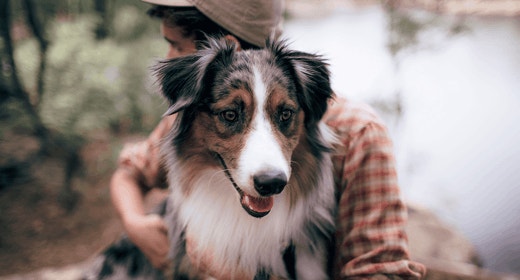

Kebanyakan manusia mengenal pelukan sebagai tanda kasih sayang dan persahabatan yang erat. Maka karena cinta, kita merasakan dorongan kuat untuk memeluk anjing . Dan mereka adalah tipe sahabat terbaik. Sebagai orang tua hewan peliharaan, kita suka menyambut sahabat kita yang lucu ini dengan pelukan. Namun, apakah anjing menyukai pelukan? Dalam survei IAMS™*, 83% orang tua anjing mengatakan bahwa anjing mereka juga menyukai pelukan. Apakah ini benar? Kami akan mencoba dan mendapatkan jawaban untuk pertanyaan ini.
Jawaban singkatnya adalah tidak. Anjing tidak suka pelukan. Sekarang, mari kita lihat sedikit penjelasan tentang hal ini.
Beberapa anjing menikmati pelukan, tetapi biasanya hanya dengan pemilik atau anggota rumah tangga mereka. Jika tidak, mereka tidak peduli mengenai hal ini. 'Pelukan terlalu berlebihan bagi banyak anjing dan harus dicegah jika anjing tidak mengenal individu dengan baik', saran James Serpell, B.Sc., Ph.D., Profesor Etika Kemanusiaan & Kesejahteraan Hewan di University of Pennsylvania School of Veterinary Medicine.
Jadi, mengapa anjing tidak suka pelukan? Untuk memahami hal ini, kita mungkin perlu melihat apa yang sebenarnya dirasakan anjing ketika Anda mencoba memeluknya.
Berikut ini adalah apa yang mungkin dialami anjing Anda ketika Anda mencoba memeluknya:
Memeluk adalah perilaku manusia dan bukan perilaku anjing. Hewan-hewan ini secara fisik tidak bertumbuh untuk interaksi semacam itu. Kita berdiri tegak, jadi kita menghadap orang lain. Anjing merangkak, membuat pelukan menjadi tindakan yang tidak alami bagi mereka. Oleh karena itu, mereka lebih suka mengendus ramah.
Sebagai manusia, memeluk anjing Anda mungkin tampak seperti cara paling murni untuk mengekspresikan cinta, namun, bagi anjing, pelukan dirasakan sebagai perilaku mendominasi. Rasanya seperti seseorang mencoba untuk menegaskan kontrol atas mereka. Hal ini bisa membuat stres, terutama jika dilakukan oleh orang asing.
Sejak zaman kuno, pertahanan naluri pertama anjing adalah melarikan diri dari bahaya. Dan memeluk membuat mereka merasa terjebak dan terkurung. Sebagai manusia, kita juga merasa canggung ketika seseorang yang hampir tidak kita kenal memberi kita pelukan lama dan erat, bukan? Anjing juga merasakan hal yang sama. Sampai batas tertentu, mereka juga ingin melarikan diri.
Mengendus adalah cara anjing mengekspresikan cinta. Namun, kita manusia pasti tidak menganggap mengendus dengan arti yang sama. Dan tidak peduli seberapa besar kita mencintai teman anjing kita, kita merasa sedikit tidak nyaman dengan tindakan ini. Demikian pula, hewan peliharaan Anda mungkin merasa pelukan itu tidak nyaman. Jangan khawatir. Bahasa tubuh anjing akan memberi Anda semua tanda yang perlu Anda ketahui tentang tingkat kenyamanan mereka. Tetapi untuk memahami tanda-tanda ini, Anda harus belajar membacanya. Jadi, mari kita pahami beberapa tanda yang menunjukkan bahwa anjing Anda tidak nyaman.
Anjing mencoba menghindari apa pun yang membuat mereka stres. Jadi, jika anjing Anda memalingkan muka ketika Anda memeluknya, berarti mereka tidak menyukai pelukan. Teman berbulu Anda mungkin juga akan membuka matanya lebar-lebar sambil memalingkan muka dan ini memungkinkan Anda untuk melihat mata paus mereka. Mata paus adalah ketika Anda melihat bagian putih mata anjing. Nah, itu adalah indikasi lain dari stres dan ketidaknyamanan.
Anjing pada umumnya fleksibel ketika santai. Jika anjing Anda menjadi kaku saat Anda melingkarkan tangan memeluk mereka, Anda mungkin harus melepaskan mereka. Anjing Anda mungkin juga akan menurunkan atau menyelipkan ekornya di bawah perut karena stres. Selain itu, Anda juga harus memperhatikan telinga hewan peliharaan Anda. Telinga yang diturunkan adalah tanda anjing yang stres.
Bukan berita baru bahwa kita menguap saat kelelahan. Namun, jika anjing Anda menguap selama pelukan , mereka sedang stres. Ini adalah cara mereka menyampaikan bahwa mereka tidak menyukai sesuatu.
Setiap anjing itu unik. Meskipun sebagian besar mereka merasa tidak nyaman dengan pelukan, beberapa mungkin suka dipeluk. Berikut ini cara Anda dapat memastikan apakah anjing kesayangan Anda tidak merasa tercekik saat Anda memeluknya:
Mengibaskan ekor dapat berarti beberapa hal. Namun, Anda tahu bahwa anjing Anda senang ketika mereka mengibaskan ekornya secara penuh. Kibasan yang lambat dan santai berarti anjing Anda merasa tenang dan nyaman.
Menempatkan cakarnya di atas pelukan menandakan bahwa anjing anda menyambut bentuk perhatian ini. Cakar anjing dapat melakukan lebih dari sekedar berjalan dan menggali lubang. Ini adalah salah satu cara komunikasi yang paling efektif bagi mereka.
Jangan khawatir jika anjing Anda tidak ingin berpelukan. Ada banyak cara yang lebih sehat yang dapat Anda lakukan untuk menunjukkan bahwa Anda masih sahabat mereka:
Anjing umumnya tidak mengenali pelukan sebagai tindakan kasih sayang. Namun, mereka belajar untuk menerima pelukan dari pemiliknya.
Anjing Anda mungkin tidak melihat pelukan seperti manusia. Bagi sebagian besar anjing, pelukan itu tidak nyaman.
Ya. Anjing suka dipeluk karena mereka mencintai Anda.